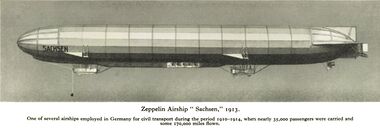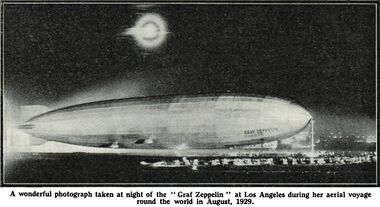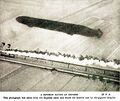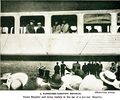Category:Zeppelins
1909: Bassett-Lowke advert for toy Zeppelins [image info]
1913: The "Sachsen" Zeppelin airship [image info]
1920: A Zeppelin at Sea [image info]
1920: Count Zeppelin (in the white hat) in the Gondola of a Zeppelin airship, with army leaders [image info]
1920: A Zeppelin racing an express train [image info]
1920: A Zeppelin cruising above the SS Imperator [image info]
1928: LZ-127 Graf Zeppelin over Philadelphia [image info]
1929: LZ-127 Graf Zeppelin over Los Angeles [image info]
1931: Marklin 5408 and 13806 Zeppelin airship model [image info]
The Zeppelin airships built by the Zeppelin Airship Construction Company are a distinctive and iconic image of the 1930s. Huge in scale, and futuristic-looking at the time, Zeppelins captured the public's imagination, and were widely assumed at the time to have become a permanent fixture of aeronautics – for a while, world record-breaking skyscrapers tended to be built with Zeppelin mooring towers. Many people thought that Zeppelins would be operating on transatlantic routes alongside aeroplanes through the Twentieth Century and into the Twenty-First (or until some new form of craft was invented to replace it), and Zeppelins are a common feature of alternative fictitious "steampunk" histories.
Internals
Zeppelins and safety
During development
Many Zeppelins were accidentally destroyed during development and testing by avoidable carelessness and by the ground crew's inexperience and unfamiliarity with the characteristics and requirements of the new type of aircraft, resulting in a small but significant number of deaths (including XXXXX).
However, no fare-paying passenger died in any Zeppelin incident until the Hindenburg disaster.
During World War One
Initially, when Germany used Zeppelins to bomb parts of England, the Zeppelin seemed invulnerable. Able to fly higher than most aircraft, even if you could see a Zeppelin, you couldn't shoot it, making the Zeppelin a threatening symbol. The flipside of this invulnerability was that the extreme height needed to avoid defensive aircraft made it difficult to bomb accurately, and some Zeppelin raids seemed to just bomb the first industrial-looking area they encountered and turn around and go home. This meant that the Zeppelin threat was partly skewed to wards the psychological rather than just the tactical.
Once more aircraft became available that could climb to the Zeppelin's altitudes, pilots found that just shooting a Zeppelin didn't bring it down. It was theoretically possible to successfully strafe a line of bullet holes along the full length of a Zeppelin, and, as long as one missed the fuel tanks, the "shot" craft would still obstinately refuse to fall out of the sky – it would certainly leak hydrogen, but given the vast volume of enclosed gas, the rate at which the gas would bleed out through a finger-sized bullethole meant that a shot Zeppelin would normally have plenty of time to turn around and slowly head back to the Continent.
This all changed when it was realised that shooting a Zeppelin with flares or tracer bullets (pyrotechnic bullets designed to leave a high-visibility firework-like trail, useful for targeting) reliably ignited the hydrogen, bringing down the craft in a fireball.
Londoners celebrated the new vulnerability of the dreaded Zeppelin, and bought postcard sets showing the step-by step destruction of the craft.
Between the Wars - "Foreign" Zeppelins
Airships effectively disappeared from Germany after World War One:
- The German crews destroyed their airships when Germany lost the war, rather than have them fall into enemy hands. This just left two airships outside military control that were still being completed.
- LZ 120 Bodensee (1919) was handed over to the Italian Navy and renamed Esperia.
- LZ 121 Nordstern (1920) was handed over to France and renamed Méditerranée.
France and Italy had their own native airship companies, so they had the necessary infrastructure and personnel to be able to deal with the two airships.
This left Germany Zeppelin-free
The US also wanted their own Zeppelin, and although the company had initially been legally forbidden to build any more large airships, the Allies were persuaded to allow the rules to be relaxed in order to allow the US to commission the construction of a brand new Zeppelin, LZ 126, which became ZR3 "Los Angeles". The construction of the Los Angeles helped keep the Zeppelin company afloat until enough funds could be raised from public and private donations to construct the LZ 127 Graf Zeppelin.
The Graf Zeppelin, LZ 127
The creation of the Graf Zeppelin and its subsequent high-profile PR success, was a significant source of German national pride.
1927 commentary
In 1927 the Zeppelin Company (Luftschiffbau- Zeppelin) had resumed work at the factory at Friedrichshafen by the production of standard parts for the construction of a new airship, and a vessel of some 3,710,000 cu. ft. capacity, designated L.Z.127, was constructed.
The airship, which is best known by the name of "Graf Zeppelin," was completed in 1928, and launched on September 18. Many notable flights were accomplished and, later, a regular transatlantic service was operated. On October 11, 1923, the airship left Friedrichshafen for Lakehurst, N.J., U.S.A., with a crew of 40 and 20 passengers, under the command of Dr. Eckener. In spite of unfavourable weather the journey of approximately 5,000 miles was completed in 4 days and 155 hours. During the summer of 1929 the "Graf Zeppelin" made a remarkable flight round the world. This flight started from Lakehurst on August 8, when, passing via the Azores, the Scilly Islands and Paris, the airship reached Friedrichshafen in the then record time of 55.5 hours. From thence the vessel flew direct to Tokyo, a distance of nearly 7,000 miles in 101.75 hours. After a short stay at Tokyo, the journey to Los Angeles across the Pacific, a distance of 5,400 miles was covered in about 79 hours, and the final stage to Lakehurst across the North American continent, some 3,000 miles, was undertaken in under 52 hours. The total distance traversed on this remarkable journey was estimated at about 21,500 miles, and the whole time occupied was just three weeks, of which only about twelve and a half days were actually spent in the air, the resulting average flying speed being about 78 m.p.h. The performances of the "Graf Zeppelin" served as an indication of the reliability and safety in operation which could be obtained by a rigid airship, and they provided evidence of the advanced stage which had been reached in the development of that type of aircraft. The use of airships in commercial air transport will be considered in the next chapter.
— , M.J.B. Davy, , Interpretative History of Flight, , 1937
The Hindenburg
The destruction of airship LZ 129 Hindenburg wiped out the future of Zeppelins as commercial passenger aircraft.
Named after Paul von Hindenburg (1847-1934), who had been Germany's President for a little over nine years until his death in August 1934, the Hindenburg was the new Zeppelin flagship (succeeding LZ 127 Graf Zeppelin), the first of a new class of Zeppelin that represented the biggest airships in the world, surpassing the deceased R-101.
Abandoned switchover to helium
Alarmed by the accidental destruction of the British R.101 in 1930 (which effectively ended British airship development), the Zeppelin company decided to abandon their planned LZ 128 design (which was intended to continue using flammable hydrogen as a lift gas) in favour of a new LZ 129, which was to use the less efficient (but totally inert) helium.
Helium was scarce and expensive. The only way to get it was from oilfields and gasfields where the impervious layers of rocks that trapped oil and gas also trapped any residual helium left over from the formation of the Earth that was gradually migrating outwards to escape. Over millions of years, these structures caught and concentrated helium, which could be captured after drilling.
Although the US government organised the capture and storage of helium from US oilfields as a strategic natural resource, export was restricted, and when the Hindenburg's designers realised that they wouldn't be able to get helium, they adapted the design back to hydrogen, with the increased lifting capacity allowing the gondola to be even bigger.
1936: Entering service
After test trials and some publicity appearances, Hindenburg entered commercial service in 1936, carrying out seventeen Atlantic round trips during that year.
The 1937 Hindenburg disaster
1936: The Hindenburg at Lakehurst, the year before the disaster. Note the circular track used to keep the tethered Zeppelin facing into the wind [image info]
Having performed one round trip to South America in March 1937, Hindenburg was completing the first leg of its first round-trip to the US of the 1937 season (to Lakehurst, New Jersey, in May 1937) when it burst into flames while moored at Lakehurst prior to disembarkation.
Unfortunately for the Zeppelin industry (and airships in general), the Zeppelin company had tried to made the craft's 1937 arrival in the US a major media event – which it indeed turned out to be, for all the wrong reasons.
Hindenburgs arrival in NJ was covered live by radio journalist Herbert Morrison and his sound engineer, and since the live commentary was not going to be able to be broadcast live, Morrison and his engineer managed to record the commentary to a disc recorder. Realising what a story they had, the recorded lacquered discs were flown to Chicago and, in a radio broadcasting first, broadcast across the entire US NBC radio network.
Morrison's shocked and horrified descriptions of what he saw happening were compelling and made the listener feel as if they were at the scene themselves and experiencing the disaster first-hand. Additionally, a number of news companies had been persuaded to send film crews to cover the arrival: their footage, with Morrison's emotional commentary dubbed over the top, made for shocking cinema newsreels, especially given that the cinemagoers would have been accustomed to seeing newsreels as showing really quite boring footage of rather mundane events. Further enhancing the sense of panic in Morrison's commentary it seems that the portable recorder ran at a slightly wrong rpm, making Morrison's voice seem faster and higher-pitched.
The result was that a shocked international audience associated zeppelins with the prospect of fiery death, making tickets almost unsaleable.
1938: Graf Zeppelin II
Thanks to the Hindenburg disaster, the sister ship, LZ 130 Graf Zeppelin (sharing a name with LZ 128, and often referred to as the Graf Zeppelin II) never took a commercial customer, and after its maiden voyage in September 1938 was used mainly for military reconnaissance.
1940: Scrapping
With World War Two now underway, no prospect of obtaining helium from the US, and no obvious military use for large airships that burst into flames when hit by a single incendiary round at almost any point along their huge bodies, Hermann Göring ordered in April 1940 that the two surviving Graf Zeppelins 128 and 130, alongwith the unfinished 131 airframe, be scrapped for their duralumin frames, which could be reused for making conventional aircraft.The order was completed that month, and the giant hangars demolished in May.
Survivability
The majority of the 97 passengers and crew on the Hindenburg actually survived the crash. Thirteen passengers and 22 crew (and one member of the ground crew) perished, meaning that over sixty percent of those onboard lived to tell the tale. By comparison, when a modern airliner crashes, the fatality rate tends to be 100%
Mooring towers
The Zeppelin's nose was used as a mooring point.
Once the tower was snagged by the mooring cable, pulling the cable taught would pull the nose of the Zeppelin to the tower peak, with the Zeppelin allowed to naturally align itself with any wind. With the Zeppelin reasonably stable and the gondola at a fixed distance and height from the tower centre, an enclosed gangway could be extended to allow the passengers to embark or disembark at the building's roof.
US and German working practices differed with regard to the height of the tower, with US airships tending to use a tall tower, to keep the airship a safe distance away from the ground. German working practice was to use a shorter tower, so that the gondola almost sat on the ground – for safety, the tail of the Zeppelin would also be tethered, and since the wind direction was liable to change, and the Zeppelin absolutely HAD to be kept aligned with the wind direction, the German Zeppelin mooring towers tended to be surrounded by a large circular railway track: the rear of the airship was then attached to a railway-style truck, and the truck would be carefully moved around the track to make sure that the airship was always kept aligned with the wind.
Although transiting at height was a slightly alarming prospect, given that the Zeppelin wasn't likely to change its angle from the horizontal, and height and distance were "locked" by the tether, the only real variable that could interfere with the gangway was the wind direction. While sudden gusts of air can happen at ground level through chaotic interactions of wind and ground shape, once one is up above the buildings, turbulence is less common (and if the weather was bad enough to create turbulence, the Zeppelin, which could happily stay aloft indefinitely without using any fuel, could either wait for the weather to improve, or could go to a nearby airfield with Zeppelin docking facilities.
Since Zeppelin passengers would tend not to be those not interested in very highest speed flight (those people would take aeroplanes), landing delays would be less of a problem, and given that mooring towers were not that difficult to build, any company offering a flight to a new location, landing at a building, would tend to make sure that they had alternative landing sites.
Zeppelins and skyscrapers
Zeppelin mooring towers were included in the designs for the Empire State Building (NYC), Rand Building (Buffalo, NY), Thomas Jefferson Hotel (Alabama), and intercontinental hotel, Chicago.
It is difficult to find evidence that these were actually ever used: Although the idea of making a luxury transatlantic crossing, then stepping off a walkway onto the roof of the Empire State Building and taking a grand art deco elevator down to the Manhattan streets below is alluring, one suspects that, in a competitive environment, architects wanting to have the world's largest building might have been tempted to gain extra footage,cheaply, by plonking a mast on top.
Hugo Eckener (1868-1954)
Hugo Eckener was a journalist trained in psychology when he met Count von Zeppelin at the launch event for the Zeppelin LZ-1. Eckener realised that this was a new field that he wanted to be involved in, and he joined the Zeppelin company to produce their publicity materials.
Although without formal mechanical training, Eckener's acute mind quickly grasped all the problems associated with this new field of transport engineering – in a subject where there were no formally trained experts, Eckener trained himself to be THE world expert in Zeppelin design, engineering and navigation.
Eckener's traumatic experience crashing and wrecking his first command, the first time out (the LZ-8) ... and still keeping his job ... probably helped to shape his obsession with safety – he knew only too well, from humiliating first-hand experience, how a moment's lapse in concentration, or a strategic error in allowing an airship to be in the wrong place at the wrong time when an unfortunate gust of wind came along, could turn an apparently perfect flight into utter and lethal disaster. Eckener also had a background in sailing (as a hobby), which meant that he had a mindset that could visualise surrounding weather patterns and the tactical placement of a wind-sensitive craft. A conventionally-trained pilot used to small aircraft could not be expected to know how to deal with the handling characteristics of a delicate craft the size of a small football stadium, and in an environment where most airship crashes seemed to be arguably either due to pilot error or bad weather, or poor planning to avoid bad weather, Eckener's unique set of skills and experience made him the perfect Zeppelin commander.
If you were taking a trip anywhere by airship. Eckener was the guy that you wanted to have at the controls.
After World War One, Eckener helped persuade the Allies to allow the construction of the Los Angeles, and fund-raised for the building of the LZ-127 Graf Zeppelin. The success of the Graf Zeppelin in a number of famous world-first and record-breaking flights put a portrait of Eckener on the front page of Time magazine in 1929, and made him a national and international celebrity in Germany, to the point where he was asked to run for office (he declined).
Pages in category ‘Zeppelins’
This category contains only the following page.
Media in category ‘Zeppelins’
The following 18 files are in this category, out of 18 total.
- A Zeppelin at Sea (WBoA 4ed 1920).jpg 2,365 × 3,000; 1.95 MB
- A Zeppelin cruising above the SS Imperator (WBoA 4ed 1920).jpg 1,982 × 3,000; 1.19 MB
- A Zeppelin in its hangar (WBoA 4ed 1920).jpg 2,112 × 3,000; 1.39 MB
- A Zeppelin racing an express train (WBoA 4ed 1920).jpg 3,000 × 2,518; 1.47 MB
- Count Zeppelin and army leaders in the gondola of a Zeppelin (WBoA 4ed 1920).jpg 3,000 × 2,509; 1.61 MB
- Giffards Airship, 1852, model (IHoF 1937).jpg 3,000 × 1,882; 1.42 MB
- Graf Zeppelin airship DLZ-127, Märklin 5406 13806 (MarklinCat 1936).jpg 2,500 × 1,257; 1.03 MB
- Graf Zeppelin LZ-127 at night in Los Angeles, in August 1929 (MM 1931-08).jpg 3,000 × 1,635; 720 KB
- Graf Zeppelin over Philadelphia, in 1928 (WBoA 6ed 1928).jpg 3,000 × 2,397; 1.61 MB
- Inside a Zeppelin (WBoA 4ed 1920).jpg 1,943 × 3,000; 1.9 MB
- Marklin classic aircraft, low-res (Marklin Magazine 1984).jpg 725 × 478; 91 KB
- Model Aeroplanes and Flying Machines, Bassett-Lowke (MRaL 1909-06).jpg 1,453 × 2,200; 538 KB
- Märklin 1140 Graf Zeppelin, detail.jpg 640 × 360; 138 KB
- Sachsen Zeppelin Airship, 1913, model (IHoF 1937).jpg 3,000 × 1,029; 713 KB
- The Hindenburg LZ129 at Lakehurst, USA, in 1936 (IHoF 1937).jpg 3,000 × 1,939; 1.29 MB
- Zeppelin catwalk (WBoA 4ed 1920).jpg 3,000 × 2,150; 1.01 MB
- Zeppelin II 1909, Card 23, Aviation (Wills 1910).jpg 3,188 × 1,676; 1.2 MB
































